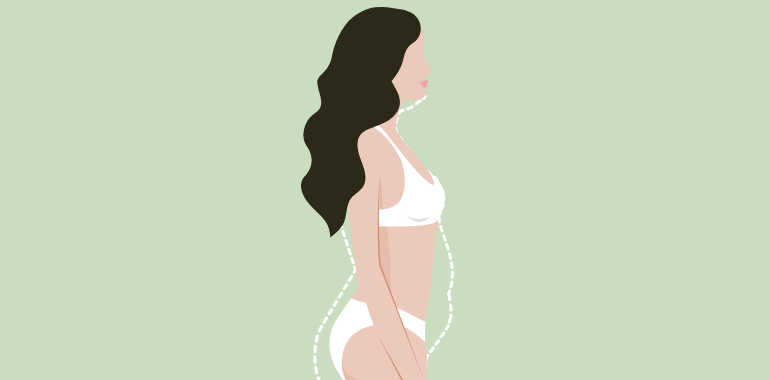Table Of Contents
Weight loss journeys often come with a burning question: where do you lose weight first? Understanding how your body sheds fat can set realistic expectations and help track progress effectively. Different body areas respond uniquely to weight loss efforts, with factors like gender, genetics, and body composition playing crucial roles. This article explores the science behind initial fat loss patterns, helping you recognize genuine progress beyond what the scale shows.
First Signs of Fat Loss: What to Expect
When your body begins to shed pounds, it follows a predetermined pattern rather than targeting specific trouble spots. Fat loss occurs systemically, not locally, regardless of which exercises you perform. The initial changes often happen in areas with less fat storage and more metabolic activity.
The first visual stages of fat loss typically manifest as subtle changes. You might notice your face appearing slimmer, clothes fitting differently around your upper body, or increased energy levels before seeing dramatic changes on the scale. These early indicators signal real physiological changes happening inside your body.
The Gender Factor: How Men and Women Lose Fat Differently
Men and women store and lose fat differently due to hormonal influences. Testosterone and estrogen significantly impact where fat accumulates and how readily it’s released during weight loss. These differences explain why weight loss journeys vary between genders even with identical diet and exercise protocols.
Hormones don’t just determine where fat is stored—they also influence how quickly it’s mobilized during caloric deficits. This explains why some body areas respond faster than others when you begin losing weight, creating the common pattern where fat loss becomes visible in certain regions before others.
Women’s Fat Loss Journey: Upper Body First, Lower Body Last
For most women, fat loss begins noticeably in the upper body regions. The face, neck, and arms typically show changes first, followed by the midsection and breasts. This pattern relates to how estrogen influences fat storage, particularly in the lower body regions designed to support pregnancy and lactation.

The hips, thighs, and buttocks are often the last areas where women notice fat reduction. These areas contain alpha receptors that resist fat breakdown, making them particularly stubborn. Consistent effort eventually yields results in these regions, but patience is essential as these changes typically emerge later in the weight loss journey.
Also, read – How Do You Get Rid of Face Fat?
Men’s Weight Loss Pattern: Torso and Middle Lead the Way
Men typically begin losing weight around their midsection and torso area. This pattern follows the principle that the last place to gain fat is often the first place to lose it. Since men tend to accumulate fat in their abdominal region due to testosterone’s influence, this area often shows initial changes during weight loss.
The face and neck frequently display early signs of fat loss in men as well. These changes can be particularly noticeable as the jawline becomes more defined and facial features sharpen. The chest and back typically follow, while lower body fat may take longer to reduce significantly.
The Science of Belly Fat Reduction
Belly fat consists of two distinct types: subcutaneous (under the skin) and visceral (surrounding organs). Visceral fat responds more quickly to weight loss efforts because it’s metabolically active and has better blood supply. This explains why waist measurements often decrease before visual changes in belly appearance become obvious.
Signs that you’re losing belly fat include improved energy levels, clothes fitting differently around the waist, and enhanced overall well-being. Losing belly fat brings substantial health benefits beyond appearance, including reduced inflammation and improved metabolic health.
- You look more fit: when you lose belly fat, your natural shapes emerge, and you look younger and physically fit.
- Your clothes fit properly: Yes! When you begin to lose weight, you should notice a change in how your dress fits.
- You feel less hungry because you have replaced those carbs with healthier proteins and fiber-based diets.
- Your well-being improves: a potbelly can impair your self-esteem and overall psychological well-being.
Visual Markers of Fat Loss Progress
The visual stages of fat loss often begin with subtle changes that may not register on the scale. Face thinning frequently happens first, with cheeks becoming less full and jawlines more defined. This occurs because facial fat is metabolically active and tends to respond quickly to caloric deficits.
As fat loss progresses, collarbone and shoulder definition increase, followed by changes in the upper arms and chest. The waist typically narrows next, with hip and thigh changes coming later for most people. These visual markers provide valuable feedback beyond scale weight, highlighting the importance of taking progress photos during weight loss journeys.
The Three Stages of Weight Loss Transformation
Weight loss occurs in three distinct physiological stages, each with unique characteristics and challenges:
1. The Glycogen depletion stage
During the initial days of caloric restriction, your body depletes stored glycogen (carbohydrate reserves). This phase creates rapid weight loss, mostly from water released as glycogen breaks down. While encouraging, this isn’t primarily fat loss but sets the stage for true fat burning to begin.
2. The fat loss stage
After glycogen depletion, your body shifts to burning stored fat for energy. This stage delivers steady, sustainable weight loss when paired with proper nutrition and exercise. The rate slows compared to the initial phase, but the lost weight now comes primarily from fat stores rather than water.
3. Metabolic stage
In this advanced stage, your metabolism adapts to consistently utilize fat for energy. For some, this includes ketosis, where the body efficiently burns fat and produces ketones. This stage requires patience and consistency but yields the most significant body composition changes.

When Will You Notice Results? Setting Realistic Timelines
The timeline for noticing weight loss varies significantly based on starting point, approach, and individual factors. Generally, changes become noticeable after losing about 5-10% of your body weight. For most people, this translates to seeing visible differences after 3-4 weeks of consistent effort.
Early weight loss (first week) largely represents water weight rather than fat loss. True fat loss becomes more apparent in weeks 3-4, especially if you incorporate resistance training alongside dietary changes. People closest to you may notice changes before you do, as daily self-observation makes gradual changes harder to detect.
Also, read – Is Pilates Good for Weight Loss?
Fat Loss vs. Muscle Loss: What Your Body Burns First
During weight loss, your body can burn both fat and muscle tissue for energy. Under ideal conditions with moderate caloric deficits and sufficient protein, your body preferentially burns fat while preserving muscle mass. However, several factors influence this balance:
- Caloric deficit severity. A severe caloric deficit triggers muscle breakdown alongside fat loss.
- Protein intake. Adequate dietary protein helps preserve muscle mass during weight loss.
- Exercise type. Resistance training stimulates muscle synthesis and helps preserve muscle mass.
Research published in the American Journal of Clinical Nutrition revealed that high-protein diets effectively maintain muscle mass during weight loss. Additionally, studies suggest that incorporating resistance training significantly improves muscle retention compared to diet-only approaches.
The Critical Difference: Losing Weight vs. Losing Fat
Losing weight and losing fat represent two distinct processes with different outcomes. Weight loss refers to reducing overall body mass, which includes fat, muscle, and water. Fat loss specifically targets adipose tissue while preserving lean muscle mass, resulting in improved body composition.
Weight loss without proper strategy often leads to muscle loss, metabolic slowdown, and potential rebound weight gain. In contrast, strategic fat loss focuses on preserving muscle through adequate protein intake and resistance training, maintaining metabolic rate and creating a more defined physique with better long-term health outcomes.Losing Weight Losing Fat Reducing overall body mass, including muscle, fat, and water. Specifically reducing the amount of fat in the body while preserving lean body mass. Typically measured using a scale (total body weight). Measured using body fat percentage tests, such as calipers, DEXA scans, or bioelectrical impedance analysis. Weight loss affects fat, muscle, bone density, and water content. Fat loss primarily targets adipose tissue while aiming to preserve muscle mass and other lean tissues. Rapid weight loss without focus on fat can lead to muscle loss, nutritional deficiencies, and metabolic slowdown. Fat loss with muscle preservation improves body composition, metabolic rate, and overall health. Often involves calorie restriction without emphasis on macronutrient balance. Emphasizes a balanced diet with adequate protein intake to support muscle maintenance. May include cardio but often lacks resistance training if not properly planned. Combines cardiovascular exercise with resistance training to optimize fat loss and muscle preservation. Can be unsustainable if too restrictive, leading to potential rebound weight gain. More sustainable when combined with proper nutrition and exercise, leading to long-term adherence and results. May not lead to desired body shape; can result in a “skinny fat” appearance (thin but high body fat percentage). Leads to improved body composition, defined muscles, and better overall aesthetics. Can slow down metabolism due to muscle loss and lower overall energy expenditure. Maintains or boosts metabolism by preserving muscle mass, thereby sustaining higher energy expenditure. Rapid, non-targeted weight loss can lead to frustration and dissatisfaction if visual changes are not as expected. More likely to result in positive self-image and satisfaction due to visible improvements in body composition.
Why Scale Weight Doesn’t Tell the Full Story
The scale measures total body mass but fails to distinguish between fat, muscle, water, and other tissues. Daily weight fluctuations often reflect water retention, glycogen levels, and digestive contents rather than actual fat gain or loss. These fluctuations can mask genuine progress in body composition.
More reliable indicators of fat loss include measurements (waist, hips, arms), how clothes fit, progress photos, and body composition analysis. These metrics provide better feedback about where do you lose fat first and overall body transformation than scale weight alone. They capture improvements in body shape and composition that weight measurements miss entirely.
Also, read – Baking Soda for Weight Loss – Shedding Pounds with Pantry Staples
10 Early Signs Your Body Is Losing Fat
Beyond scale changes, these physical and physiological markers indicate your body is successfully burning fat:
1. Wearing clothes that are a bit looser
As you shed some weight, you might start to feel your clothes fitting comfortably around your waist, hips, and thighs. This change is often one of the signs that you’re losing weight.
2. Feeling more energized
As you drop some pounds, you may find yourself having a boost in energy levels, making your daily tasks feel less tiring and more doable.
3. Brighter mood
Losing weight can trigger the release of endorphins, which can lift your spirits and lower feelings of tension and worry.
4. Sleep
Shedding extra pounds can enhance your sleep quality by reducing issues like sleep apnea and other disturbances that affect your rest.
5. Increased physical endurance
Tasks like walking, going upstairs, or working out will become less challenging as your endurance improves over time.
6. Noticing reduced swelling or lost inches
Before seeing differences on the scale, you might observe a decrease in puffiness or changes in measurements around areas like the waist, hips, arms, or legs.
7. Encouraging comments from others
Your friends, family members, or colleagues might start to notice shifts in your appearance and offer encouraging words as a form of support.
8. Enhancing digestive health
Shedding pounds, particularly when combined with adopting a diet can help alleviate digestive problems such, as bloating, constipation, and acid reflux.
9. Alleviating joint discomfort
Shedding excess weight can ease the pressure on your joints, resulting in decreased pain and enhanced flexibility.
10. Managing blood pressure
Even a slight weight reduction can lead to improved blood pressure levels, which promotes heart health.
Stubborn Fat Areas: Why Some Spots Take Longer
Certain body areas resist fat loss due to their biological purpose and receptor composition. These “stubborn fat” regions contain high concentrations of alpha receptors, which slow down fat mobilization, while having fewer beta receptors that accelerate fat breakdown.
For women, stubborn fat typically accumulates in the lower body (hips, thighs, buttocks) due to estrogen’s influence. Men generally struggle more with lower abdominal fat and love handles. These areas typically respond later in the weight loss process and may require more time and persistence to show visible changes.
Visceral vs. Subcutaneous Fat: Different Rates of Loss
The two main types of body fat respond differently to weight loss efforts:
Visceral fat surrounds internal organs and poses greater health risks. The good news? It’s metabolically active and typically reduces faster when you create a caloric deficit. This explains why waist measurements often decrease early in weight loss journeys, as visceral fat reduction occurs before visible subcutaneous fat changes.
Subcutaneous fat lies just beneath the skin and contributes more to visible body shape. This type of fat tends to be more resistant to mobilization, especially in stubborn areas. The rate of subcutaneous fat loss varies significantly by body region, with some areas responding quickly while others require prolonged effort.
Also, read – Do Cold Showers Burn Fat? The Most Unexpected Way Explained
How Your Body Shape Influences Fat Loss Patterns
Your natural body shape, largely determined by genetics, influences where you store fat and how you lose it. The three primary body types each display different fat loss patterns:
Apple shapes (central obesity) tend to carry weight around the midsection and typically lose fat first from this area. While this pattern presents higher health risks initially, it also responds faster to weight loss efforts, with visible changes appearing relatively quickly.
Pear shapes carry more weight in the lower body (hips, thighs, buttocks). These individuals usually notice upper body fat loss first, with lower body changes coming later. Despite the frustration of stubborn lower body fat, this pattern generally poses fewer immediate health risks than central obesity.
Hourglass/balanced shapes distribute fat more evenly throughout the body. They typically lose fat proportionally across all areas, maintaining their overall body proportions even as they slim down. This pattern often results in balanced, harmonious changes throughout the weight loss journey.
Understanding where do you lose weight first helps establish realistic expectations for your personal weight loss journey. While you can’t control the order in which your body sheds fat, you can optimize your approach by focusing on sustainable habits that promote healthy fat loss while preserving muscle mass. By tracking multiple progress markers beyond the scale, you’ll gain a clearer picture of your body’s transformation process.
William is from Canada, he is passionate nutrition & wellness writer. William understands that the topic of wellness is still not well understood, so his goal is to enlighten and teach people how to live healthier and happier in their bodies.










I agree with the author of this article that men and women have different stages of weight loss. Does this mean that as a woman I have to walk more steps per day and where do I lose fat first?
Hi, Eliza🙂
Each body is unique, but generally, women and men may experience weight loss differently. As for steps per day, focus on what feels right for you and fits into your lifestyle. Regarding fat loss, it varies, but often starts in different areas for men and women. For women, it might begin in parts of the body with little fat content, and the last area is their hips.